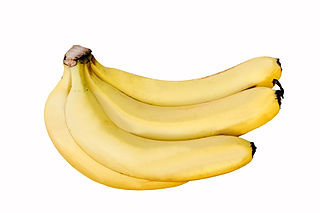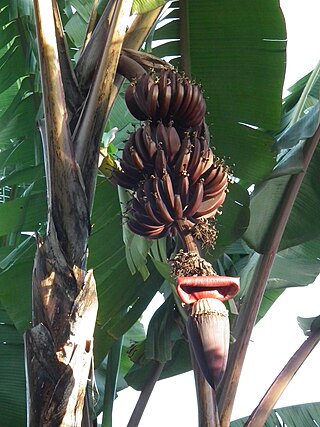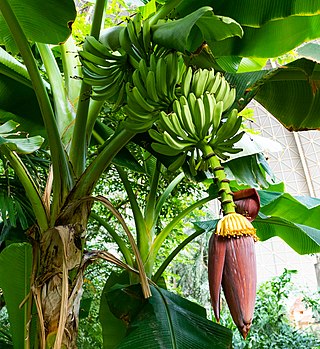
A banana is an elongated, edible fruit – botanically a berry – produced by several kinds of large herbaceous flowering plants in the genus Musa. In some countries, cooking bananas are called plantains, distinguishing them from dessert bananas. The fruit is variable in size, color, and firmness, but is usually elongated and curved, with soft flesh rich in starch covered with a rind, which may have a variety of colors when ripe. The fruits grow upward in clusters near the top of the plant. Almost all modern edible seedless (parthenocarp) bananas come from two wild species – Musa acuminata and Musa balbisiana. Most cultivated bananas are M. acuminata, M. balbisiana, or hybrids of the two.

The blood banana, is a variety of the wild banana Musa acuminata native to Sumatra, Indonesia. The blood banana is an ornamental plant, named for the dark red patches on its leaves, though its small-seeded fruits are also edible. It grows 6' to 8' tall in the wild, but is well-adapted to container growing and can be maintained at 3' to 5'. It grows best in full or partial sun and is hardy in zones 9 - 11.

Cavendish bananas are the fruits of one of a number of banana cultivars belonging to the Cavendish subgroup of the AAA banana cultivar group. The same term is also used to describe the plants on which the bananas grow.

Gros Michel, often translated and known as "Big Mike", is an export cultivar of banana and was, until the 1950s, the main variety grown. The physical properties of the Gros Michel make it an excellent export produce; its thick peel makes it resilient to bruising during transport and the dense bunches that it grows in make it easy to ship.

The Dwarf Cavendish banana is a widely grown and commercially important Cavendish cultivar. The name "Dwarf Cavendish" is in reference to the height of the pseudostem, not the fruit. Young plants have maroon or purple blotches on their leaves but quickly lose them as they mature. It is one of the most commonly planted banana varieties from the Cavendish group, and the main source of commercial Cavendish bananas along with Grand Nain.

The Goldfinger banana (FHIA-01) is a banana cultivar developed in Honduras. The cultivar, developed at the Honduran Foundation for Agricultural Research (FHIA) by a team of scientists led by Phillip Rowe and Franklin Rosales, has been bred to be pest-resistant and crop-yielding.

Red bananas are a group of varieties of bananas with reddish-purple skin. Some are smaller and plumper than the common Cavendish banana, others much larger. When ripe, raw red bananas have a flesh that is creamy to light pink. They are also softer and sweeter than the yellow Cavendish varieties, some with a slight tangy raspberry flavor and others with an earthy one. Many red bananas are exported by producers in East Africa, Asia, South America, and the United Arab Emirates. They are a favorite in Central America as a form of aphrodisiac juice, along with being a favourite in India to promote fertility but are sold throughout the world.

The Grand Nain banana is a banana cultivar of Musa acuminata. It is one of the most commonly cultivated bananas and a member of the commercial Cavendish banana cultivar group. It is also known as the Chiquita banana because it is the main product of Chiquita Brands International.

Musa acuminata is a species of banana native to Southern Asia, its range comprising the Indian Subcontinent and Southeast Asia. Many of the modern edible dessert bananas are from this species, although some are hybrids with Musa balbisiana. First cultivated by humans around 10 kya, it is one of the early examples of domesticated plants.

Saba banana is a triploid hybrid (ABB) banana cultivar originating from the Philippines. It is primarily a cooking banana, though it can also be eaten raw. It is one of the most important banana varieties in Philippine cuisine. It is also sometimes known as the "cardaba banana", though the latter name is more correctly applied to the cardava, a very similar cultivar also classified within the saba subgroup.

Fe'i bananas are cultivated plants in the genus Musa, used mainly for their fruit. Unlike most other cultivated bananas they are diploids of the AA-type. They are very distinct in appearance and origin from the majority of bananas and plantains currently grown. Found mainly in the islands of the Pacific, particularly French Polynesia, Fe'i bananas have skins which are brilliant orange to red in colour with yellow or orange flesh inside. They are usually eaten cooked and have been an important food for Pacific Islanders, moving with them as they migrated across the ocean. Most are high in beta-carotene.

Lady Finger bananas are diploid banana cultivars originating in Malaysia or Indonesia, belonging to the Sucrier subgroup of the AA banana cultivar group. Lady Finger banana is the most widely cultivated AA cultivar and is one of the world’s most popular local bananas. Banana fruits are finger-sized, thin skinned, and deliciously sweet.

The Latundan banana is a triploid hybrid banana cultivar of the AAB "Pome" group from the Philippines. It is one of the most common banana cultivars in Southeast Asia and the Philippines, along with Lacatan and Saba bananas. Its Malaysian name is pisang rastali.

Señorita bananas are diploid cultivars of the banana Musa acuminata originating in the Philippines. They are very small stout bananas which, like all bananas belonging to the AA cultivar group, are known for being extraordinarily sweet.

Thai banana is a banana cultivar originating from Thailand, belonging to the triploid ABB banana cultivar group. This banana cultivar is one of the most important banana fruits in tropical and subtropical regions worldwide. Thai bananas contain many nutrients and are often eaten when ripe or prepared into many other dishes. Almost all parts of the Thai banana tree have useful uses for humans.

Musa × paradisiaca is a triploid cultivar of banana, belonging to the Cavendish banana subgroup, originating as the hybrid between Musa acuminata and Musa balbisiana, cultivated and domesticated by human very early. Most cultivated bananas and plantains are cultivars of this hybrid. Linnaeus originally used the name M. paradisiaca only for plantains or cooking bananas, but the modern usage includes hybrid cultivars used both for cooking and as dessert bananas. Linnaeus's name for dessert bananas, Musa sapientum, is thus a synonym of Musa × paradisiaca.
Masak Hijau bananas are triploid banana cultivars from Malaysia. It is a member of the commercially important Cavendish banana subgroup. It is a popular banana cultivar in Southeast Asia and the West Indies.

Cardava bananas, also spelled cardaba or kardaba, is a triploid hybrid (ABB) banana cultivar originating from the Philippines. It is primarily a cooking banana, though it can also be eaten raw. It is commonly confused with the more ubiquitous and closely related saba banana because they are used identically in traditional Filipino cuisine. Their common names can be interchanged in everyday usage though they are different cultivars.





















